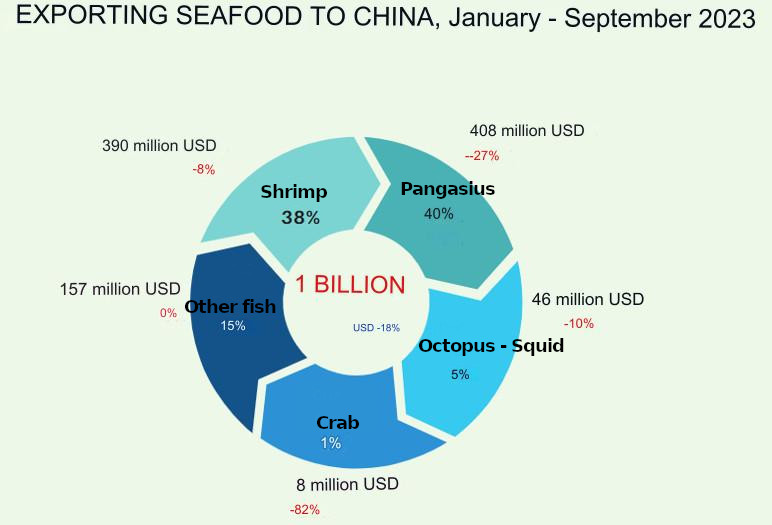Industry news
China: Large potential for Vietnamese seafood
Datetime:2023-11-22The Chinese market holds an increasingly important position for Vietnamese seafood enterprises. In recent years, China has been in the top 3 seafood import markets of Vietnam, second only to the US and Japan. In 2023, seafood exports to China will decline because of reduced export prices, but the prospects and space in this market are still open for seafood export businesses.
In 2022, Vietnamese seafood exports to China will reach 1.6 billion USD, an increase of 66% - record sales and record growth, after decreasing to 990 million USD in 2021 due to restrictions caused by the Covid epidemic.

Source: Vasep
In 2023, seafood exports to China will also encounter the same problems as other markets: falling prices and high inventory, so in the first 9 months of the year seafood export revenue to this market decreased by 18% to reach 1 billion USD.
The products with the highest proportion, pangasius (40%) and shrimp, 38%, both had their export value reduced to China, shrimp decreased by 8%, and pangasius decreased by 27%.
.jpg)
Source: zhuanlan.zhihu
Other seafood species exported to China also saw a sharp decrease in sales, in which octopus squid decreased by 10%, crab decreased by 82%, and other types of fish remained at the same level as the same period in 2022.
However, if considering each aquatic species individually, in 2023 there will be many species showing positive signs with strong growth: such as whiteleg shrimp, black tiger shrimp, sea shrimp (shrimp), jack fish, yellow snapper, and mackerel. , grouper fish, scad, glass eye fish, octopus, clams...
And there are a number of species whose sales have decreased, including: pangasius, lobster, squid, crab, crawfish, fish cakes, surimi...
The localities that import the most Vietnamese seafood are Guangdong, Zhanjiang, Guangxi, Fujian, Shanghai...
China is increasingly dependent on imported seafood
Many Vietnamese businesses have identified that the Chinese market has been and will continue to be a potential destination for Vietnamese seafood if both the seafood industry and the business community grasp the needs, tastes and opportunities from the market.
In 2023 and the coming years, there are a number of favorable factors, bringing opportunities and space for Vietnamese seafood in China: The Covid epidemic has ended, China's trade with the world is completely normal; China's economy has positive signs, seafood demand is recovering: pangasius, black tiger shrimp, whiteleg shrimp, squid, octopus; favorable geographical position for Vietnamese enterprises to export to China, spending Logistics fees are reduced and less than other countries; China will stop importing seafood from Japan and will replace it with other sources of supply, including Vietnam...
Some shifts in economic investment in China are also considered opportunities for Vietnamese seafood. It seems that the super-profitable and highly profitable economic sectors are receiving more investment attention, so investment in aquaculture has decreased, and the country's seafood exports have also gradually decreased in recent years, due to both Covid factors and economic transition trends. Therefore, economic experts estimate that China will increasingly depend on imported seafood, similar to the model of Western countries.
Geopolitical fluctuations, inflation, energy crisis... cause seafood consumption demand of large countries such as the US, EU, Japan to decline sharply, while China's imports are increasing.
If the conflict in the Middle East escalates, fuel costs will increase again and the energy crisis continues combined with inflation and high interest rates, forecasting exports to the US and EU markets in 2024 - 2025 will more difficult, and China will be the target market of many seafood exporting countries.
Conquering the market: needs more efforts
However, to take advantage of and promote opportunities from the Chinese market and the potential of Vietnam's seafood industry, B2B trade activities need to be further strengthened, in which local-level trade needs to be paid attention to. than; There needs to be exchange and sharing of information about market needs and regulations, especially when there are changes in import-export policies; Expand the list of businesses and aquatic products allowed to export to China, opening more doors for fresh aquatic species to be exported to China: spiny lobsters, live crabs...; Cooperate to promote licensing approval processes for enterprises with codes to export seafood to China: Maintain smooth customs clearance at border gates; Promote road and rail traffic connections in border areas; Cooperate in building cold storages and logistics facilities to serve Vietnam-China agricultural and aquatic trade, especially cross-border trade.
Author: Le Hang | Vasep (Translated from the original in Vietnamese)

